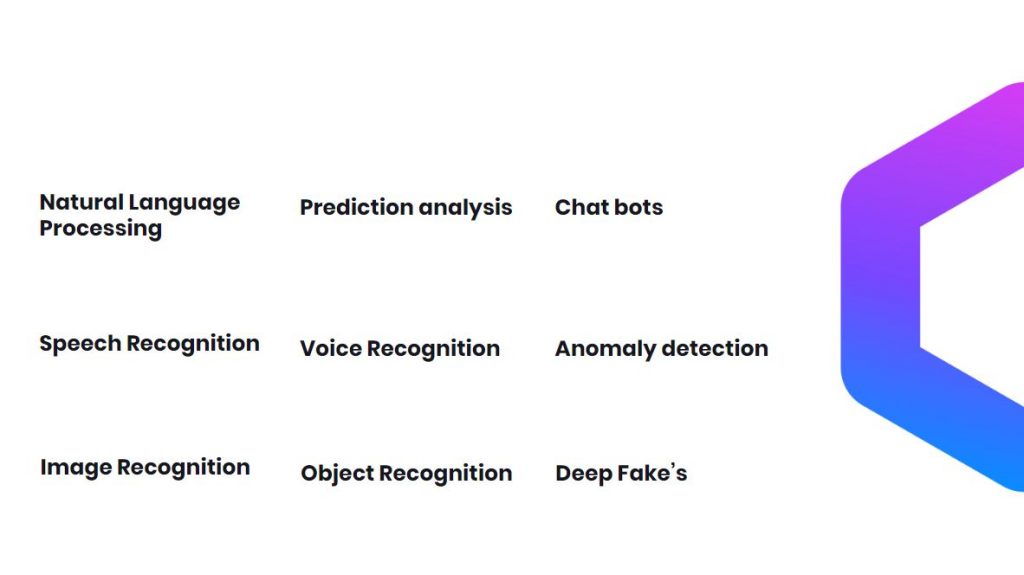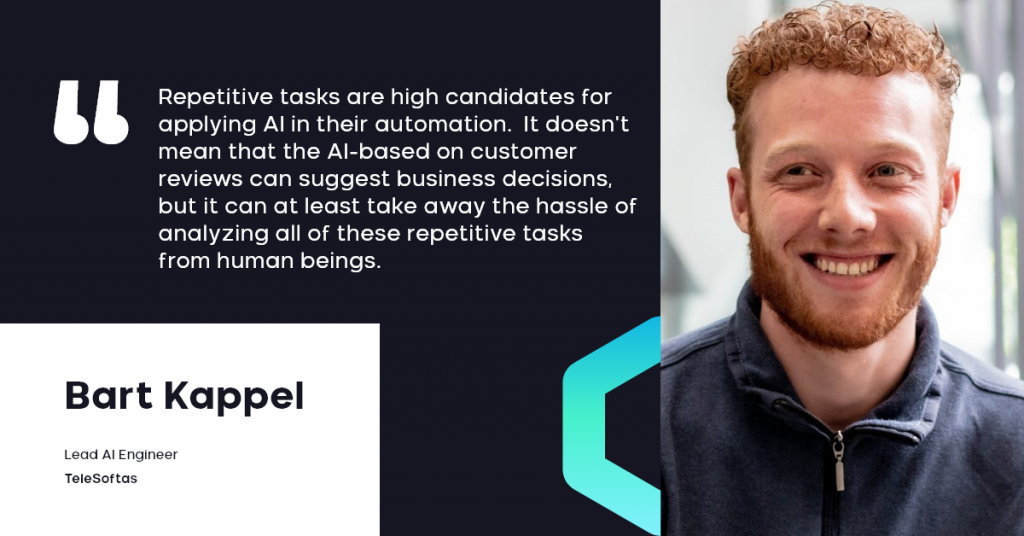What is AI like today? What myths surround this topic and what can we anticipate from artificial intelligence in the future?
In his keynote presented during our AI: Is Your Business Ready for It? webinar, TeleSoftas Lead AI Engineer Bart Kappel presented a thorough overview of AI and main aspects that are crucial in determining the successful implementation of this technology.
For your convenience, we have compiled the best insights from Bart and prepared an AI Adoption Workbook that awaits you at the end of the article. All to guide you step-by-step into the world of AI and utilize it to the maximum benefit of your business. Let’s dive!
Defining AI
AI is a very broad topic. It contains several domains, several multitudes of knowledge and it has been researched since the 1950s. Nowadays the main concept and the main topic we hear about AI is machine learning. Just to clarify the understanding – AI is not, per definition, machine learning. Machine learning is just a part of AI.
Weak AI vs. Strong AI
We could name two kinds of artificial intelligence: weak AI and strong AI. And while Strong AI is the AI that we all know due to our exposure to science fiction, Weak AI is something that we see all around us every day. E.g. when we use Google Maps, the way it determines the best route for us is influenced by AI. Either partially, or fully. Facebook can already recognize people when their photos are uploaded and that is one form of AI, to be specific – facial recognition.
As we are all still under quarantine and our governments are slowly opening up the countries and lowering the lockdown restrictions, the models that are used to influence their decision making regarding mobility predictions are also formed by AI, in this case, machine learning.
Strong AI is the AI that we are all familiar with for many years of watching movies like Terminator, iRobot, and so on. These are the cognitive decision-making systems that “take over the world” which all a very familiar scenario. This AI is actually still far away from being actively developed and ready for production. It’s a research topic all across the world. According to some predictions, a cognitive artificial intelligence capable of human thinking should arrive by the year of 2030.

Myth #1: Any repetitive task can be solved by AI
From that strong AI we also have a lot of myths that were born during the recent years. One common thing that we often hear is that any repetitive task can be solved by AI – just build a model, use AI, and it will be done. Once again, that is not entirely true. It all depends on the domain, on whether you have the resources and people available.
Some repetitive tasks though, are definitely solvable or improvable with the help of AI. If, for example, we have a customer service platform and we receive lots of common questions about a product and we have people answering those questions, we could think of automating this process or at least improving it by implementing AI solution, which, in this case, would be in the form of a chat bot which would reduce the time that our employees take with customer interaction.
Myth #2: AI is going to take away our jobs
Another very common myth that is floating around is that AI will steal our jobs by replacing people. This is still far ahead scenario and again not entirely true. AI will create a job transition as other revolutions recorded in our history had. For example, the Industrial Revolution took away some jobs but it made our jobs easier in the long run and that is also the goal of AI. It’s there to help us do our work more efficiently, better, and create new opportunities which we weren’t aware of before.
Leave it to AI

Repetitive tasks are high candidates for applying AI in their automation. Many companies nowadays lean on customer review analysis performed by AI. Let’s say we have a customer review and it’s either negative or positive. Instead of having a human determining if it’s positive or negative we can easily leave this task for a computer so that the employee doesn’t need to do that anymore. It doesn’t mean that the AI-based on customer reviews can suggest business decisions, but it can at least take away the hassle of analyzing all of these repetitive tasks from human beings.
Identifying and understanding the problem
We have further derived a couple of questions to understand the problems ahead when implementing AI into our projects. These questions are not limited to these three specific ones, but it is something that needs to be asked during the beginning stage before we even consider ML techniques or in-house/outsource practices.
- Do we have the domain knowledge?
In order to solve the task at-hand we need to understand what we are solving in the first place. For that, there should be an expert in-house or easily accessible that understands the domain and has in-depth field knowledge. Usually, this person is already a product manager, business owner, or other form of expert in its field. - Can the problem be automated?
At this stage we would look into the aspects of a given case an decide which aspects can be automated. If the problem at hand can’t be automated we can’t even introduce any AI solution. - Do we have data or can we collect data related to the problem?
As I already mentioned, data is crucial, so we need to assess if we have it available. Decision-makers, solution architects and engineers will require an assurance that data is available in the right quantity and quality for deep learning algorithms. Even though at this stage it’s not yet necessary to have the data already or in the right format but we need to have the critical data sources available and accessible. Data can be sourced both internally or externally, depending on the solution, which in the later case this may require contractual arrangements with third parties.
Starting the AI Journey
There are many factors that determine a successful AI integration to your business solution. From gathering the data required and determining the automatization principles to actually deploying AI to action. 84% of organizations globally believe that AI will maximize their competitive advantage and improve business differentiation and decision-makers still struggle to understand how to judge their businesses’ ability to generate value from it.
Therefore, if you have ideas on how to implement AI in your case, this could be your first step. We’ve created an AI Adoption Workbook to help companies successfully kickstart an AI strategy. This workbook will help you assess your business readiness for AI and provide step-by-step guidance to identify the roadblocks as well as the fundamentals for AI adoption. In addition, it holds a list of questions and tips to guide your own self-assessment activities, discuss in teams, and present Your AI Strategy to the stakeholders.
